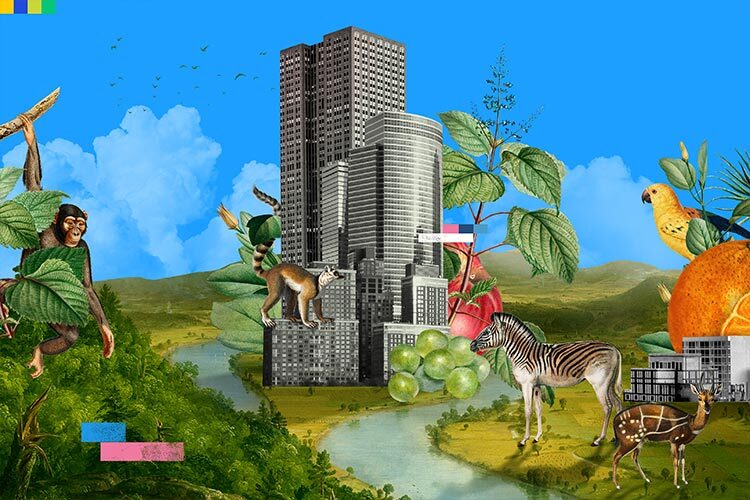Imagine that every rooftop in the neighborhood where you live has an urban garden managed by your community, and you can get fresh seasonal fruit and vegetables at a fair price. The air you breathe is clean, there’s no shortage of water, and there’s no garbage in the streets. Plus, you feel safe and inspired.
This is one of many scenarios proposed by regenerative design, a movement seeking to undo the damage inflicted on nature and find new ways of connecting to it, where the built environment leads to the co-evolution of humanity.
With the climate crisis we’re facing, it’s hard to imagine this promising future. However, one group of architects, designers, farmers, and scientists believes that it is possible to create a better world. To achieve this, we have to remember that we are part of a living planet and that societies must be built with Earth in mind.

Infographic: Oldemar González / TecScience
Regenerative design: Listening to nature
“Nature isn’t a factory for extracting the maximum benefit; it’s an environment that we have to be in balance with and on which we depend,” explains Carlos Cobreros, a research professor at Tecnológico de Monterrey’s School of Architecture, Art, and Design (EAAD), in an interview with TecScience.
Cobreros is one of many who practice regenerative design, which seeks to reduce our negative impact on the planet.
From an architectural and urban planning perspective, the idea is to build spaces where all kinds of life can flourish and thrive, taking into account the specific natural processes and cycles of the area where we want to settle.
Behind this practice is the firm belief that nature is wise, but it’s necessary to reconnect with it so as to be able to listen to it.
“It’s a paradigm shift,” says María Elena de la Torre, who is also a professor at EAAD and a member of the Tec’s regenerative design hub, which is led by Cobreros. “It’s understanding that we’re part of a living system. The climate, social, political, and economic crises we’re experiencing refute this connection.”
The park that made it
One example is Rufino Tamayo Park, located in San Pedro Garza García in the Monterrey Metropolitan Area. Some years ago, 1998 to be precise, citizens living nearby filed a complaint with the authorities in which they reported that the place was severely deteriorated and deforested.
Through citizen participation, the space began to regenerate bit by bit, allowing and promoting the spread of native Monterrey vegetation.
Today, it’s a green area with more than 40 species of trees native to the region, as well as species of birds, mammals, butterflies, insects, amphibians, and reptiles that had left the area, but returned once the environmental conditions were favorable. The community came together, and a street market was permitted.
To many people, these ideas may sound unrealistic and difficult to pull off, but there are practical steps that can be taken to achieve regenerative design.
According to Cobreros and De la Torre, the first thing to do is carry out an analysis of the place where you want to build in order to discover its essence, uniqueness, value, and potential. This is in opposition to the idea of building cities and houses that all look the same regardless of where they are.
During this part of the process, you discover the site’s specific natural cycles and its original dynamics. You see where the water runs from and where it goes, what type of soil there is, what clean energy sources there are, what species make up its biodiversity, and what materials are naturally abundant.
Once these variables have been analyzed, “the idea is to look at these aspects positively and work with them instead of removing them,” says Diana Rivera, an EAAD professor.



Rufino Tamayo Park is one example of regenerative design, where the community participated in its rehabilitation. (Photo: Asael Villanueva / TecScience)
From local to global
The next step is to develop construction plans, thinking locally. “It’s about starting with small-scale solutions that will add up to improve the global situation,” explains Cobreros.
Ideally, the most natural materials possible from the region are used to achieve this. If for some reason there aren’t any available, those that have a responsible sourcing certification should be used, avoiding polluting materials that are sourced from afar, such as asbestos, formaldehyde, petroleum, and phthalates (which are used to soften rigid plastics), for example.
What’s more, you need to think at scale in terms of the area to be covered, placing healthy food sources, hospitals, and medical centers within walking distance of the house that is being built.
You should also think in terms of time: “Imagine what will happen to that house in 50- or 200-years’ time,” says Rivera.
Besides respecting and integrating nature into construction, this practice is rooted in concepts such as biomimicry, where natural solutions are mimicked and used in the design of an object or a building. For example, copying the structure of an anthill to build a recreational center.
Psychological wellbeing
The idea of regenerative design evolved from concepts such as permaculture, a set of principles for designing agricultural, social, and political systems based on the ecosystem’s natural patterns, developed in 1978 in Australia.
Starting in the year 2000, different authors began to emerge who laid the foundations of regenerative design, such as the book Designing Regenerative Cultures by Daniel Christian Wahl. Various groups and projects have also emerged, such as Arup, the Living Building Challenge, and the Regenesis Group.
This is based on the realization that sustainability is an outdated concept, which has been insufficient in fighting a climate crisis that we cannot deny.
Every corner of the globe has been affected by this crisis. Examples include rising temperatures, environmental degradation, biodiversity loss and mass extinctions, as well as food and water insecurity.
In view of this, “we have to make strides in terms of environmental awareness because we’re already in a race against time,” stresses Cobreros.
In March 2023, a group led by Cobreros published an article in which they discussed biophilic design, a concept used within the building industry to increase the connectivity of residents to nature, to improve the psychological wellbeing of people living in the university districts of Guadalajara and Querétaro.
“We also found that there has been greater environmental awareness through biophilic design, which is a part of regenerative design,” says Cobreros.

Experts call for greater awareness in the face of the ravages of climate change. (Illustration: Eduardo Ramón / TecScience)
Present and future
According to the research professor, this practice is here to stay. At Tec de Monterrey, the hub led by Cobreros has developed the Diploma in Regenerative Design: Resilient Territories and Cities, which is taught to undergraduate students at EAAD. What’s more, they’re planning multiple projects using this type of design approach that will be carried out at different campuses and cities around the country.
According to Cobreros, De la Torre, and Rivera, there must be a profound change in the way we perceive ourselves and nature for regenerative design to gain the strength it needs to improve the global environmental situation, and we must all participate.
“We have to get rid of that ego of thinking we’re the superior species and understand that we’re just one more species,” says Rivera. “As designers and architects, we create the spaces we inhabit, so we have that impact and responsibility. I have to play my part from where I’m standing,” she concludes.







